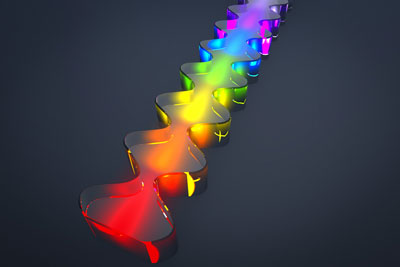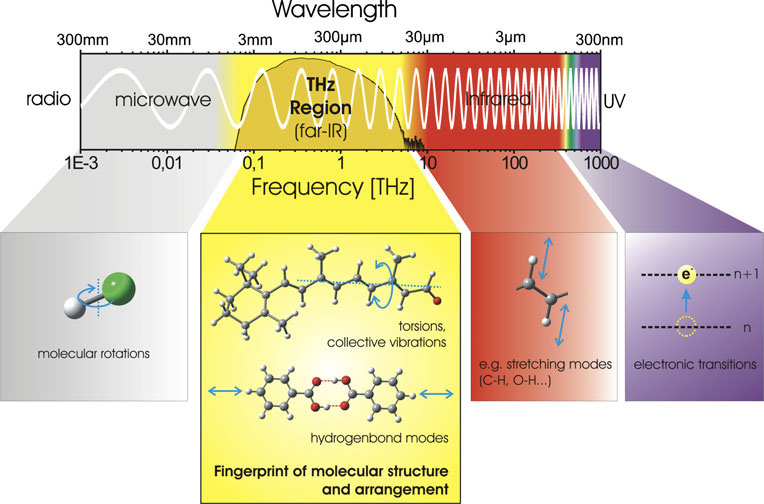Terahertz technologies explained
Terahertz technology refers to the use of electromagnetic waves in the terahertz region of the electromagnetic spectrum. The potential applications of terahertz radiation are numerous and diverse, ranging from security and materials science to communications and medicine.
Contents
Humans typically blink 4 times per second, equivalent to a frequency of 4 Hz. Blinking at a rate of 1 billion times per second, or 1 GHz, is not possible for a human being. But this is the current speed at which high-end digital devices, like magnetic memory (MRAM - magnetoresistive random access memory), operate. In order to reach the terahertz regime this speed needs to be pushed a thousand times further to a trillion times a second.
Terahertz (THz) technology refers to the use of electromagnetic waves in the terahertz (1 THz = 1012 Hz) region of the electromagnetic spectrum that covers the frequency range from roughly 0.1 to 50 THz. Terahertz electromagnetic waves occupy a middle ground between electronics waves, like microwave and radio waves, and photonics waves, such as infrared and UV waves. For example, mobile phones use microwave radiation for communication, and infrared cameras are utilized for night vision. Terahertz technology utilizes a type of electromagnetic radiation lies between the microwave and infrared regimes.
Terahertz Waves
Terahertz waves are unique among electromagnetic waves, with wavelengths ranging from approximately 10 micrometers to 1 millimeter and oscillating at frequencies of between 100 billion and 30 trillion cycles per second. Their vibration frequency coincides with the vibrations of matter-forming molecules, making it possible to detect substances through the analysis of their ‘fingerprint’ spectra. This is because nearly every molecule in the terahertz frequency range has its own distinct spectrum.

Terahertz waves are highly valued for their unique properties, including the ability to penetrate materials such as paper, clothing, wood, and walls, as well as detect air pollution. These characteristics make them ideal for use in security and medical imaging systems, which could be revolutionized by THz sources. Additionally, their high data-carrying capacity could lead to faster wireless communication in 6G and 7G technologies.
Unlike X-rays, which are ionizing and can harm living tissue, THz radiation is non-ionizing due to its small photon energy and considered safe for imaging purposes. This makes it particularly suitable for medical imaging, where it can be used to produce high-resolution images of the human body without exposing patients to harmful radiation. The technology has already been implemented in some airports for the purpose of scanning passengers and detecting dangerous objects and substances.
How to Generate Terahertz Radiation
There are several methods for generating terahertz radiation:
Photoconductive Antennas: Among all the proposed THz sources, the THz-PCA (photoconductive antenna) is the most promising one due to its advantages of efficient, low-cost, compact, and broadband radiation. This involves shining a laser or other high-power light source onto a photoconductive material, which creates a fast electrical pulse. When this pulse passes through a resonant cavity, it generates THz radiation.
Frequency Mixing: This method involves mixing two or more high-frequency signals in a nonlinear material to produce THz radiation. The frequencies of the signals must be close enough to generate THz radiation in the gap between them.
Optical Rectification: This method involves passing a high-power laser pulse through a crystal, which generates an electrical field. This electrical field can then be used to generate THz radiation.
Nonlinear Optics: This involves the interaction of intense light with a nonlinear material to generate THz radiation.
These methods are used in various THz sources, such as femtosecond lasers, solid-state sources, and microwave-based sources, each with their own advantages and limitations.
Applications of Terahertz Technology
The potential applications of terahertz radiation are numerous and diverse, ranging from security and materials science to communications and medicine. If the technological challenges of creating usable devices could be overcome, terahertz radiation could have a profound impact on many areas of our lives.
THz radiation can penetrate deeply into nonpolar and non-metallic materials such as paper, plastic, clothes, wood, and ceramics, which are typically opaque to optical wavelengths. These materials are often used for packaging, making THz imaging a useful tool for non-destructive testing and hidden object detection, as it does not harm humans like X-rays do.
Additionally, the THz region is rich in spectral features related to various physical processes, such as rotational transitions of molecules, vibrational motions of organic compounds, and lattice vibrations in solids. These characteristics make THz technology effective in detecting weapons, explosives, and chemical and biological agents concealed under various covering materials. It also makes it useful for applications such as non-destructive testing in industrial process control, where it can be used to inspect the internal structure of materials without damaging them.

Terahertz technology has a wide range of applications, with new possibilities being discovered as research in this field continues to advance. Here are a few specific examples of how terahertz technology is currently being used or researched for use:
Imaging: Terahertz imaging, also known as T-ray imaging, can be used to create images of the internal structure of materials that are opaque to visible light and other forms of electromagnetic radiation. For example, researchers have used terahertz imaging to non-destructively analyze the internal structure of paintings, such as the "Mona Lisa" by Leonardo da Vinci.
Spectroscopy: Terahertz spectroscopy can be used to identify the chemical composition of materials. For example, researchers have used terahertz spectroscopy to detect trace amounts of explosives and illegal drugs as well as harmful gases, pesticides, antibiotics, toxic chemical compounds.
Medical applications: Terahertz technology is being researched for medical applications, such as detecting cancerous tissue and diagnosing skin diseases. For example, researchers have used terahertz imaging to detect skin cancer with high accuracy.
Security and Defence: Terahertz technology is being researched for use in security and defence applications, such as detecting concealed weapons and explosives. For example, researchers have used terahertz imaging to detect concealed weapons on individuals from a distance.
Communications: Terahertz technology is being researched for use in wireless communications. THz radiation has shorter wavelengths than microwaves and therefore has higher bandwidth capacity for data transmission. Furthermore, terahertz radiation provides a more focused signal that could improve the efficiency of communication stations and reduce power consumption of mobile towers.
Quality control and non-destructive testing: Terahertz technology can be used for non-destructive testing and quality control in industries such as aerospace, automotive, and electronics. For example, researchers have used terahertz imaging to inspect the internal structure of electronic components and detect defects such as cracks and voids. Another example is the use of THz scanners for non-destructive quality control of fiberglass compounds and paint coatings in aerospace components.
Biomedical research: Terahertz technology can be used for studying biological systems and identifying potential drug targets. The absorption of THz radiation in molecular and bimolecular systems is primarily stimulated by intramolecular and intermolecular vibrations and can be used to detect biological macromolecules such as amino acids, peptides, proteins, nucleic acids and carbohydrates.
Chemical sensing: Terahertz vibrational spectra represent characteristic fingerprints for many chemical substances; hence, this technology may be used for contactless substance identification.

Food and agriculture: Terahertz technology can be used for quality control and food safety in the agriculture and food industries. For instance, THz spectroscopy can be an effective solution for pesticide residue detection because many chemicals show distinct spectral signatures in the THz range. Similarily, THz spectral signatures can be used to detect food additives or antibiotics.
Astronomy: Terahertz technology can be used for studying celestial objects and the interstellar medium. For example, researchers have used terahertz telescopes like the High Elevation Antarctic Terahertz (HEAT) telescope to study the properties of star-forming regions and the chemistry of the universe.
Art conservation: Terahertz technology can be used for non-destructive analysis of artworks and artifacts. For example, researchers have used terahertz imaging to study the internal structure of ancient pottery and identify the manufacturing techniques used.
Industrial process control: Terahertz technology can be used for monitoring industrial processes and identifying defects in products. For example, researchers have used terahertz imaging to inspect the internal structure of metal parts during the manufacturing process and detect defects such as cracks and voids.
Frequently Asked Questions (FAQs) About Terahertz Technologies
What is Terahertz Technology?
Terahertz technology is a field of science and technology that focuses on the electromagnetic waves within the terahertz frequency range. This range falls between microwave and infrared frequencies on the electromagnetic spectrum, and it can be utilized for various purposes like medical imaging, security scanning, and wireless communication.
Why is Terahertz Technology important?
Terahertz technology is important due to its unique properties. It is non-ionizing, which means it's safe for human exposure. It can penetrate a wide variety of non-conducting materials such as clothing, paper, cardboard, wood, masonry, plastic, and ceramics. Therefore, it's useful in various fields like medical imaging, security checks, and wireless data communication.
What are the applications of Terahertz Technology?
Terahertz technology has a wide range of applications including but not limited to: medical imaging for detecting cancer cells, security screening for detecting concealed weapons, quality control in the pharmaceutical industry, studying chemical reactions in chemistry, data transfer in wireless communications, and in astronomy for detecting molecules in space.
What are the challenges of Terahertz Technology?
The major challenges of terahertz technology include the creation and detection of terahertz waves. The "terahertz gap" is a term used to describe the lack of technology or methods that can generate, manipulate, and detect terahertz waves. Additionally, atmospheric water vapor can absorb terahertz radiation, limiting its range.
What is the future of Terahertz Technology?
The future of terahertz technology looks promising with ongoing research aimed at finding efficient ways to generate, detect, and manipulate terahertz waves. The technology can revolutionize various fields like security, medicine, communications, and chemistry once the challenges are overcome.
